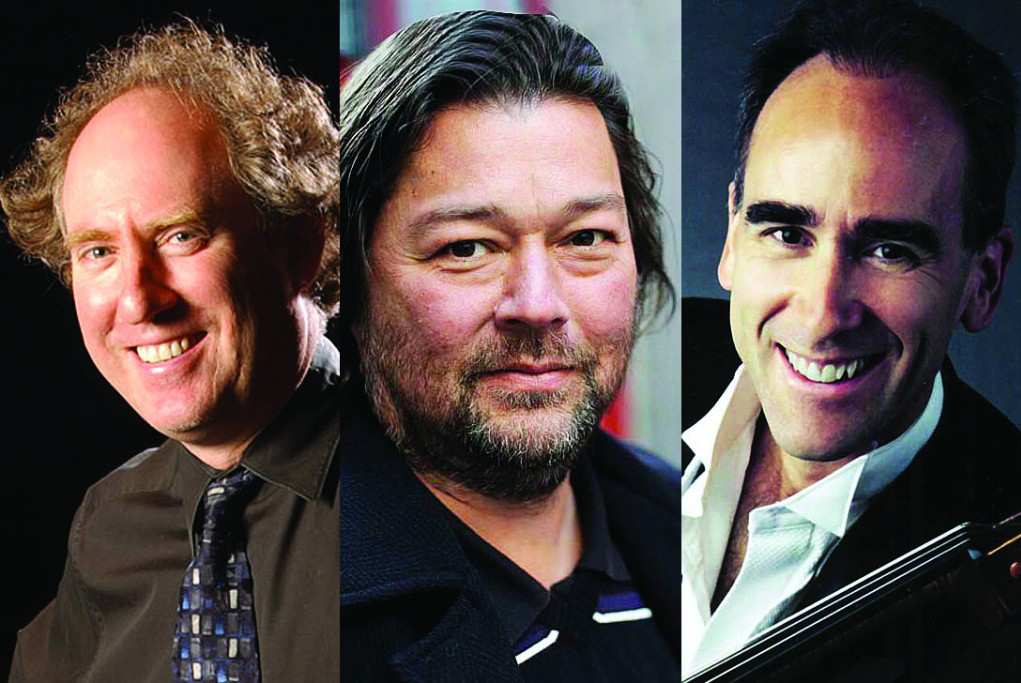
KahaneSwensenBrey Trio at Koerner Hall, Sunday, March 8, 2015.
The onset of daylight savings time is usually a bit disorienting, particularly since 2007, when it was moved to the second Sunday in March. In Toronto this means a misfit between late afternoon and early evening light that evokes a sense of summer (or used to) occurring when the weather remains frigid. One might call this “climactic dissonance.”
When the KahaneSwensenBrey Trio last played together in the 80s, Daylight Savings began in April instead. Whether they remembered this today, or were affected by the shifting clocks, they must think about how much time has passed when they perform now, given the 25 year hiatus in their collaboration.
They resumed playing together in 2012. In this sense they are a rather new trio at the same time as they are a rather old one. Kahane is 59, Brey is 60 and Swensen is 55, which is not exactly musical dotage, but one wonders if their reunion is motivated in part by their entering the wind down phase of their careers.
In keeping with the slight oddness of the day, a few things that don’t happen that often occurred at this performance. First: there was a substitution announced from the stage, in which a trio – Café Music by Paul Schoenfield, – was replaced by a duet. Why program changes occur is never explained but usually the substitutions are somewhat equivalent. When a group that is called a Trio elects to leave one performer out, it is that much more puzzling.
I was mildly concerned that I was not going to hear a piece that was described as “highly caffeinated”, a welcome afternoon energy boost, and also, at a bit of a loss without any information about the Debussy Sonata for Cello and Piano that was substituted. This concern dissipated as soon as Brey played the first masterful cello notes of the composition. The forcefulness and complexity of the first two trios had been impressive but it was only when the cello was given its moment at the outset of the Sonata that I realized I was about to really hear the instrument get its due.
After the unexpected program substitution was announced, the audience was subjected to a longer than usual wait for the performers to emerge through the stage door. It was long enough that a witty patron began a sarcastic applause-for-no-one, which released nervous laughter.
The other incident that recurred throughout the concert was uncertain timing of applause between movements. While there is no absolute policy or practice at Koerner Hall about when to applaud or withhold applause, it is generally the case that audiences wait until a piece in three movements is over before giving it up for the performers, and when applause occur after the first movement, as they did in the first trio, the Mozart Piano Trio No 4 in E Major 542, it creates some doubt as to whether the piece is finished. The three performers also appeared to be in doubt, as they did not uniformly acknowledge the applause or ignore them, they just looked half embarrassed and half appreciative.
The other problem with unexpected applause is that they cannot swell, as many are wishing to restrain them, so the piece can continue. As a result you get faint, tepid applause which seem to comment on the performance when they don’t. This happened after every movement of the Mozart as well as through the Schumann Piano Trio No 1 in D Minor, Opus 63. When it actually became time for full-throttle hand clapping at the end of the final piece of the concert, the very stirring Ravel Piano Trio in A Minor, there was actually a slight hesitation as if the audience had gotten it wrong so often it was not certain how to get it right. It’s also possible that this is not the work to bring a concert to a resounding close, as it was intended to be the first piece after the intermission, but was pushed back in favour of the Debussy.
After watching the musicians for a while I began to ask myself if there was something in their signalling that may have evoked this confusion from the audience. There were occasional stumbles, a bit of dyssynchrony, though nothing glaring, and a lot of signals between the performers that were easily perceived. Between the 1st and 2nd movement of the Ravel Piano Trio in A Minor, Swensen and Brey actually had a jocular exchange of words. Kahane nods and sways a lot, and was also nodding to his page-turner as well as Swensen and Brey, so that signals were really flying.
The challenge of synchronization for a chamber music group is greater to some degree than for a much larger orchestra because the orchestra has a conductor, who is a visual focus of synchronization, for the audience as well as the musicians. Slight discomfort can result when the signals are evident to the audience. Whether this was visible throughout Koerner Hall I cannot say, but the sense of three perfectly integrated performers was lacking.



